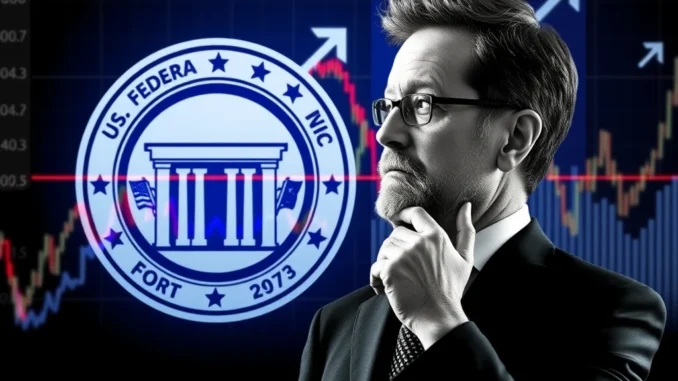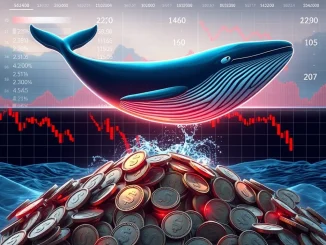
Are you ready for a potential market shake-up? Crypto markets are buzzing as BitMEX co-founder Arthur Hayes weighs in on two massive macroeconomic forces that could dictate where we’re headed: the U.S. Federal Reserve’s upcoming policy update and Europe’s escalating defense spending. Let’s dive into Hayes’ insightful analysis and explore what these developments could mean for your crypto portfolio.
Decoding Fed Policy and Quantitative Tightening: A Potential Liquidity Boost?
All eyes are on the U.S. Federal Reserve as they gear up to announce their latest policy decisions. The big question on everyone’s mind, and one that Arthur Hayes highlighted on X, is: Will the Fed signal a halt to Quantitative Tightening (QT)?
But what exactly is Quantitative Tightening, and why should you care?
- Quantitative Tightening (QT) Explained: Imagine the Fed as a central bank that can influence the economy’s money supply. During periods of economic stress, like the 2008 financial crisis or the recent pandemic, the Fed engages in Quantitative Easing (QE). This involves buying assets like government bonds to inject liquidity into the market, essentially making it easier for businesses and individuals to borrow money. QT is the reverse process – the Fed reduces its balance sheet by either selling these assets or letting them mature without reinvesting, thereby pulling liquidity out of the market.
- Impact of QT on Markets: Generally, QT is considered a contractionary monetary policy. Less liquidity in the market can lead to tighter financial conditions, potentially impacting asset prices, including cryptocurrencies. Conversely, the end of QT or a slowdown in its pace could be interpreted as a loosening of financial conditions, potentially providing a boost to markets.
- Hayes’ Perspective: Arthur Hayes is keenly watching for signals that the Fed might be considering pausing or ending QT. A signal to end QT could be a powerful indicator that the Fed is becoming less hawkish and potentially paving the way for a more accommodative monetary policy in the future. This shift in sentiment can often trigger positive reactions in risk assets like Bitcoin and other cryptocurrencies.
The anticipation surrounding the Fed’s decision is palpable. Traders and investors are hanging on every word, trying to decipher clues about the future direction of monetary policy. Will the Fed hint at a pivot? The answer could significantly impact the short-term market direction.
EU Rearmament: A New Player Shaping Market Dynamics?
While the Fed’s moves are always closely watched, Arthur Hayes brings another fascinating element into the equation: Europe’s increasing defense spending. In the wake of geopolitical tensions, particularly in Eastern Europe, many European nations are significantly boosting their military budgets. Hayes points out that this spending is often financed by “printed euros,” essentially meaning expansionary fiscal policy in the Eurozone.
But how does EU rearmament connect to the global market and potentially offset the impact of U.S. fiscal policy?
- Europe’s Fiscal Stimulus: Increased defense spending acts as a form of fiscal stimulus. Governments are injecting money into the economy through procurement contracts, infrastructure projects related to defense, and employment in the military and defense industries. This injection of funds can boost economic activity within the Eurozone.
- Offsetting U.S. Fiscal Drag?: Hayes raises a crucial question: Could this European fiscal stimulus, fueled by “printed euros,” counteract any potential negative fiscal impact from the U.S.? The U.S. has been grappling with high inflation and has been implementing measures to cool down the economy, which can sometimes lead to a fiscal drag (slowing down economic growth through reduced government spending or increased taxes). If European spending is substantial enough, it could provide a counterbalancing force on a global scale.
- Impact on Cryptocurrency Markets: The interplay between U.S. and European fiscal and monetary policies can have ripple effects across global markets, including cryptocurrencies. If European stimulus gains momentum while the U.S. potentially eases its monetary tightening, we could see a shift in global liquidity dynamics. This could create a more favorable environment for risk assets, including crypto.
Hayes astutely questions whether this European spending surge will become the dominant force in the near term. If EU rearmament spending outpaces the negative fiscal impacts in the U.S., it could signal that the recent market correction might be nearing its end. This is a critical factor to consider for anyone involved in the cryptocurrency market.
Navigating Market Direction and Potential Volatility: Key Takeaways from Hayes’ Analysis
Arthur Hayes’ analysis presents two potential scenarios, hinged on the relative strength of Fed policy and European fiscal measures. Understanding these scenarios can help you better navigate the choppy waters of the cryptocurrency market.
| Scenario | Key Drivers | Potential Market Outcome | Implications for Crypto |
|---|---|---|---|
| Scenario 1: EU Spending Dominates |
|
|
|
| Scenario 2: Fed Policy Remains Dominant |
|
|
|
Actionable Insights:
- Stay Informed on Fed Policy: Closely monitor Fed announcements and speeches for signals about the future of Quantitative Tightening. Any indication of a pause or end to QT could be a positive catalyst for the market.
- Track European Defense Spending: Keep an eye on news and reports related to European defense budgets and spending plans. Increased spending could inject liquidity into the global economy.
- Prepare for Volatility: Regardless of which scenario unfolds, expect continued market volatility in the near term. Having a risk management strategy in place is crucial.
- Diversify and Research: Don’t put all your eggs in one basket. Diversify your portfolio and continue to research different cryptocurrencies and market trends.
Conclusion: A Pivotal Moment for Market Direction
Arthur Hayes’ analysis highlights a potentially pivotal moment for financial markets. The interplay between the U.S. Federal Reserve’s Fed policy decisions and Europe’s burgeoning EU rearmament initiatives creates a complex and dynamic landscape. Whether European spending can truly offset the effects of U.S. monetary policy remains to be seen, but it’s a critical factor that could shape market direction in the coming months. By staying informed and understanding these macroeconomic forces, you can better position yourself to navigate the exciting, yet unpredictable, world of cryptocurrency investing.



